Solidification Mechanism of Pb and Cd in S2−-Enriched Alkali-Activated Municipal Solid Waste Incineration Fly Ash
Abstract
:1. Introduction
2. Materials and Methods
2.1. Materials
- (1)
- Ground granulated blast-furnace slag (GGBS) powder
- (2)
- MSWI fly ash
- (3)
- Other
2.2. Preparation of SEAA
2.3. Preparation of MSWI Fly Ash Solidified Body
2.4. Experiment and Research Contents
2.4.1. Effects of Na2S Dosage on the Solidification Performance for Pb and Cd by SEAA
- (1)
- Mixing proportion and preparation of specimens
- (2)
- Preparation of heavy metal leaching agent
- (3)
- Determination of heavy metal contents
2.4.2. Effects of GGBS Dosage on the Solidification Performance for Pb and Cd by SEAAS
- (1)
- Mixing proportion and preparation of specimens
- (2)
- Preparation of the heavy metal leaching agent
- (3)
- Determination of heavy metal contents
2.4.3. Effects of S2−-Enriched Modification on the Alkalinity of the Activator
- (1)
- Preparation of testing fluid
- (2)
- Determination of pH value
2.4.4. Effects of S2−-Enriched Modification on the Mechanical Properties of Fly Ash Solidified Bodies
- (1)
- Mixing proportion and preparation of specimens
- (2)
- Compressive strength test
2.4.5. Effects of SEAAS on the Micro-Morphology of MSWI Fly Ash
- (1)
- Mixing proportion and preparation of samples
- (2)
- SEM analysis
2.4.6. Effects of SEAAS on the Chemical and Molecular Composition of MSWI Fly Ash
- (1)
- Mixing proportion and preparation of samples
- (2)
- XRF analysis
- (3)
- XRD analysis
- (4)
- FT-IR analysis
3. Results and Discussion
3.1. Effects of Na2S Dosage on the Solidification Performance of SEAA for Pb and Cd
- (1)
- Solidification performance for Pb
- (2)
- Solidification performance for Cd
3.2. Effects of GGBS Dosage on the Solidification Performance of SEAAS for Pb and Cd
- (1)
- Solidification performance for Pb
- (2)
- Solidification performance for Cd
3.3. Effects of S2−-Enriched Modification on the Alkalinity of the Activator
3.4. Effects of S2−-Enriched Modification on the Mechanical Properties of MSWI Fly Ash Solidified Body
3.5. Effects of SEAAS on the Micro-Morphology of MSWI Fly Ash
- (1)
- Micro-morphology of AAS solidified body
- (2)
- Micro-morphology of SEAAS solidified body
3.6. Effects of SEAAS on the Chemical and Molecular Composition of MSWI Fly Ash
3.6.1. XRF Analysis
3.6.2. XRD Analysis
3.6.3. FT-IR Analysis
- (1)
- MSWI fly ash
- (2)
- AAS solidified body
- (3)
- SEAAS solidified body
4. Solidification Mechanism Analysis
4.1. Solidification Mechanism of the SEAA for Pb and Cd in MSWI Fly Ash
- (1)
- Effects of S2− affinity on the solidification performance of the SEAA
- (2)
- Effects of S2−-enriched modification on the solidification performance of the SEAA
4.2. Solidification Mechanism of the SEAAS for Pb and Cd in MSWI Fly Ash
- (1)
- Effects of ionic radius on the solidification performance of AAS of Pb and Cd
- (2)
- Effects of synergetic effect on the solidification performance of SEAAS for Pb and Cd
5. Conclusions
- After the inclusion of further Na2S, the SEAA’s solidification performance for Pb and Cd in MSWI fly ash increased, initially noticeably and then slightly. The critical Na2S dosage at which the solidification performance increased significantly was a Na2S dosage of 1%. The solidification performance of the SEAA for Pb in MSWI fly ash was considerably weaker than that for Cd; thus, it is challenging to solve the exceeding standard problem of Pb in the low Na2S dosage range of 0.5~1%.
- The performance of SEAAS for Pb and Cd in MSWI fly ash solidification increased as the GGBS dosage was elevated, initially noticeably and then slightly. The critical GGBS dosage at which the solidification performance increased significantly was a GGBS dosage of 25%. In the low GGBS dosage range (0~25%), SEAAS could effectively solidify Pb and Cd in MSWI fly ash, and the solidification performance for Cd was better than that for Pb, which successfully compensated for the shortcomings of the poor solidification performance of traditional AAS for Cd in MSWI fly ash.
- The chemical and molecular composition of the SEAAS solidified body were similar to those of the AAS solidified body, except that new characteristic peaks of sulfides were detected on the XRD and FT-IR spectrum of the SEAAS solidified body. The highly alkaline environment provided by SEAA promoted the dissolution of a large amount of S2− in the solvent, endowing the SEAAS with a strong ability to capture Pb and Cd to form sulfide precipitates. SEAAS not only had the capability of chemically bonding Pb and Cd using the [AlO4] network structure, but also had the function of capturing Pb and Cd to form stable sulfide precipitates.
Author Contributions
Funding
Institutional Review Board Statement
Informed Consent Statement
Data Availability Statement
Acknowledgments
Conflicts of Interest
Definition
| The definition of terms | |
| MSWI fly ash | Municipal solid waste incineration fly ash |
| Alkalia activator | Water solution sodium silicate + NaOH |
| SEAA solidified body | MSWI fly ash + SEAA |
| AAS solidified body | MSWI fly ash + alkalia activator + GGBS |
| AAS | Alkalia activator + GGBS |
| Water-binder ratio | Mass ratio of water/powder |
| GGBS | Ground granulated blast-furnace slag |
| SEAA | Alkalia activator + Na2S |
| SEAAS solidified body | MSWI fly ash + SEAA+ GGBS |
| Na2S solidified body | MSWI fly ash + Na2S |
| Silicate modulus | The molar ratio of SiO2/Na2O |
| Solidified paste | Uncondensed hardened solidified body |
References
- Huang, G.; Yang, K.; Chen, L.; Lu, Z.; Sun, Y.; Zhang, X.; Feng, Y.; Ji, Y.; Xu, Z. Use of pretreatment to prevent expansion and foaming in high-performance MSWI bottom ash alkali-activated mortars. Constr. Build. Mater. 2020, 245, 118471. [Google Scholar] [CrossRef]
- Cho, B.H.; Nam, B.H.; An, J.; Youn, H. Municipal Solid Waste Incineration (MSWI) Ashes as Construction Materials—A Review. Materials 2020, 13, 3143. [Google Scholar] [CrossRef] [PubMed]
- Ye, N.; Chen, Y.; Yang, J.; Liang, S.; Hu, Y.; Xiao, B.; Huang, Q.; Shi, Y.; Hu, J.; Wu, X. Co-disposal of MSWI fly ash and Bayer red mud using an one-part geopolymeric system. J. Hazard. Mater. 2016, 318, 70–78. [Google Scholar] [CrossRef] [PubMed]
- Yue, Y.; Zhang, J.; Sun, F.; Wu, S.; Pan, Y.; Zhou, J.; Qian, G. Heavy metal leaching and distribution in glass products from the co-melting treatment of electroplating sludge and MSWI fly ash. J. Environ. Manag. 2019, 232, 226–235. [Google Scholar] [CrossRef] [PubMed]
- Joseph, A.; Snellings, R.; Van den Heede, P.; Matthys, S.; De Belie, N. The Use of Municipal Solid Waste Incineration Ash in Various Building Materials: A Belgian Point of View. Materials 2018, 11, 141. [Google Scholar] [CrossRef] [Green Version]
- Tian, Y.; Wang, R.; Luo, Z.; Wang, R.; Yang, F.; Wang, Z.; Shu, J.; Chen, M. Heavy Metals Removing from Municipal Solid Waste Incineration Fly Ashes by Electric Field-Enhanced Washing. Materials 2020, 13, 793. [Google Scholar] [CrossRef] [Green Version]
- Quina, M.J.; Bordado, J.C.; Quinta-Ferreira, R.M. Treatment and use of air pollution control residues from MSW incineration: An overview. Waste Manag. 2008, 28, 2097–2121. [Google Scholar] [CrossRef] [Green Version]
- Wang, C.P.; Li, F.Z.; Zhou, M.K.; Chen, Y.; Chen, X. Effect of cement-MSWI fly ash hydration on the stabilisation/solidification of Pb and Cd. Mater. Res. Innov. 2015, 19, S5–S1161. [Google Scholar] [CrossRef]
- Benassi, L.; Franchi, F.; Catina, D.; Cioffi, F.; Rodella, N.; Borgese, L.; Pasquali, M.; Depero, L.; Bontempi, E. Rice Husk Ash to Stabilize Heavy Metals Contained in Municipal Solid Waste Incineration Fly Ash: First Results by Applying New Pre-treatment Technology. Materials 2015, 8, 6868–6879. [Google Scholar] [CrossRef] [Green Version]
- Yao, Z.; Xu, Z.; Shuai, Q.; Chen, X.; Jiang, Z.; Peng, X.; Li, Y.; An, R.; Jiang, X.; Li, H. Solidification of Municipal Solid Waste Incineration Fly Ash through Co-Mechanical Treatment with Circulation Fluidized Bed Combustion Fly Ash. Materials 2020, 13, 141. [Google Scholar] [CrossRef] [Green Version]
- Pisciella, P.; Crisucci, S.; Karamanov, A.; Pelino, M. Chemical durability of glasses obtained by vitrification of industrial wastes. Waste Manag. 2001, 21, 1–9. [Google Scholar] [CrossRef]
- Ragoug, R.; Metalssi, O.O.; Barberon, F.; Torrenti, J.; Roussel, N.; Divet, L.; D’Espinose De Lacaillerie, J. Durability of cement pastes exposed to external sulfate attack and leaching: Physical and chemical aspects. Cem. Concr. Res. 2019, 116, 134–145. [Google Scholar] [CrossRef]
- Loginova, E.; Proskurnin, M.; Brouwers, H.J.H. Municipal solid waste incineration (MSWI) fly ash composition analysis: A case study of combined chelatant-based washing treatment efficiency. J. Environ. Manag. 2019, 235, 480–488. [Google Scholar] [CrossRef]
- Wei, G.X.; Liu, H.Q.; Zhang, S.G. Using of Different Type Cement in Solidification/Stabilization of MSWI Fly Ash. Adv. Mater. Res. 2011, 291–294, 1870–1874. [Google Scholar] [CrossRef]
- Qiao, X.C.; Poon, C.S.; Cheeseman, C. Use of flue gas desulphurisation (FGD) waste and rejected fly ash in waste stabilization/solidification systems. Waste Manag. 2006, 26, 141–149. [Google Scholar] [CrossRef]
- Gougar, M.L.D.; Scheetz, B.E.; Roy, D.M. Ettringite and C-S-H Portland cement phases for waste ion immobilization: A review. Waste Manag. 1996, 16, 295–303. [Google Scholar] [CrossRef]
- Shi, H.; Kan, L. Leaching behavior of heavy metals from municipal solid wastes incineration (MSWI) fly ash used in concrete. J. Hazard. Mater. 2009, 164, 750–754. [Google Scholar] [CrossRef]
- Bie, R.; Chen, P.; Song, X.; Ji, X. Characteristics of municipal solid waste incineration fly ash with cement solidification treatment. J. Energy Inst. 2016, 89, 704–712. [Google Scholar] [CrossRef]
- Lampris, C.; Stegemann, J.A.; Pellizon-Birelli, M.; Fowler, G.D.; Cheeseman, C.R. Metal leaching from monolithic stabilised/solidified air pollution control residues. J. Hazard. Mater. 2011, 185, 1115–1123. [Google Scholar] [CrossRef]
- Jiang, J.G.; Xu, X.; Zhang, Y. Investigation of leaching characteristics of heavy metals during cement stabilization of fly ash from municipal solid waste. Huanjing Kexue 2006, 27, 12. [Google Scholar]
- Xu, P.; Zhao, Q.; Qiu, W.; Xue, Y. The Evaluation of the Heavy Metal Leaching Behavior of MSWI-FA Added Alkali-Activated Materials Bricks by Using Different Leaching Test Methods. Int. J. Environ. Res. Public Health 2019, 16, 1151. [Google Scholar] [CrossRef] [PubMed] [Green Version]
- Sasui, S.; Kim, G.; Nam, J.; Koyama, T.; Chansomsak, S. Strength and Microstructure of Class-C Fly Ash and GGBS Blend Geopolymer Activated in NaOH & NaOH + Na2SiO3. Materials 2020, 13, 59. [Google Scholar]
- Liu, C.; Yao, X.; Zhang, W. Controlling the setting times of one-part alkali-activated slag by using honeycomb ceramics as carrier of sodium silicate activator. Constr. Build. Mater. 2020, 235, 117091. [Google Scholar] [CrossRef]
- Huang, K.; Fan, X.; Gan, M.; Ji, Z. Use of Municipal Solid Waste Incinerator (MSWI) Fly Ash in Alkali Activated Slag Cement; Characterization of Minerals, Metals, and Materials 2019; Springer: Berlin/Heidelberg, Germany, 2019; pp. 401–410. [Google Scholar]
- El-Eswed, B.I.; Yousef, R.I.; Alshaaer, M.; Hamadneh, I.; Al-Gharabli, S.I.; Khalili, F. Stabilization/solidification of heavy metals in kaolin/zeolite based geopolymers. Int. J. Miner. Process. 2015, 137, 34–42. [Google Scholar] [CrossRef]
- Pereira, C.F.; Luna, Y.; Querol, X.; Antenucci, D.; Vale, J. Waste stabilization/solidification of an electric arc furnace dust using fly ash-based geopolymers. Fuel 2009, 88, 1185–1193. [Google Scholar] [CrossRef]
- Xu, J.; Zhou, Y.; Tang, X. Study on the solidification of heavy metals by fly ash based geopolymers. J. Build. Mater. 2006, 9, 341–346. [Google Scholar]
- Jaarsveld, J.G.S.V.; Deventer, J.S.J.V.; Schwartzman, A. The potential use of geopolymeric materials to immobilise toxic metals: Part II. Material and leaching characteristics. Miner. Eng. 1999, 12, 75–91. [Google Scholar] [CrossRef]
- Lei, M.; Tanaka, M.; Liao, B.; Tie, B.; Qin, P. Treatment of Heavy Metals from Wastewater Containing EDTA with Sulfide Precipitation. Res. Environ. Sci. 2008, 21, 150–154. [Google Scholar]
- Quina, M.J.; Bordado, J.C.M.; Quinta-Ferreira, R.M. Chemical stabilization of air pollution control residues from municipal solid waste incineration. J. Hazard. Mater. 2010, 179, 382–392. [Google Scholar] [CrossRef]
- HJ/T 300-2007; Solid Waste-Extraction Procedure for Leaching Toxicity-Acetic Acid Buffer Solution Method. Environmental Protection Industry Standards: Beijing, China, 2007.
- GB 5085.3-2007; Identification Standards for Hazardous Wastes-Identification for Extraction Toxicity. Environmental Protection Industry Standards: Beijing, China, 2007.
- GB/T17671-2021; Method of Testing Cements-Determination of Strength. State Administration for Market Regulation: Beijing, China, 2021.
- Zhang, D.; Liu, W.; Tian, F.; He, X.; Hou, H. Solidification of municipal solid waste incineration fly ash by slag cementitious material. Environ. Eng. 2008, 26, 14–16. [Google Scholar]
- Jin, M. The Technology and Final Product Research of Geopolymer Solidified with Heavy Metal. Master’s Thesis, Zhejiang University, Hangzhou, China, 2005. [Google Scholar]
- Wei, D.; Liu, W.; Mi, J.; Gao, S. Passivation Performance of Sodium Sulfide on Heavy Metal Ions in Soil. J. Northeast. Univ. (Nat. Sci.) 2013, 34, 1339–1342. [Google Scholar]
- Galiano, Y.L.; Pereira, C.F.; Vale, J. Stabilization/solidification of a municipal solid waste incineration residue using fly ash-based geopolymers. J. Hazard. Mater. 2011, 185, 373–381. [Google Scholar] [CrossRef]
- Jin, M.; Jin, Z.; Huang, C. Immobilization of Heavy Metal Pb2+ with Geopolymer. Huanjing Kexue 2011, 32, 1447–1453. [Google Scholar]
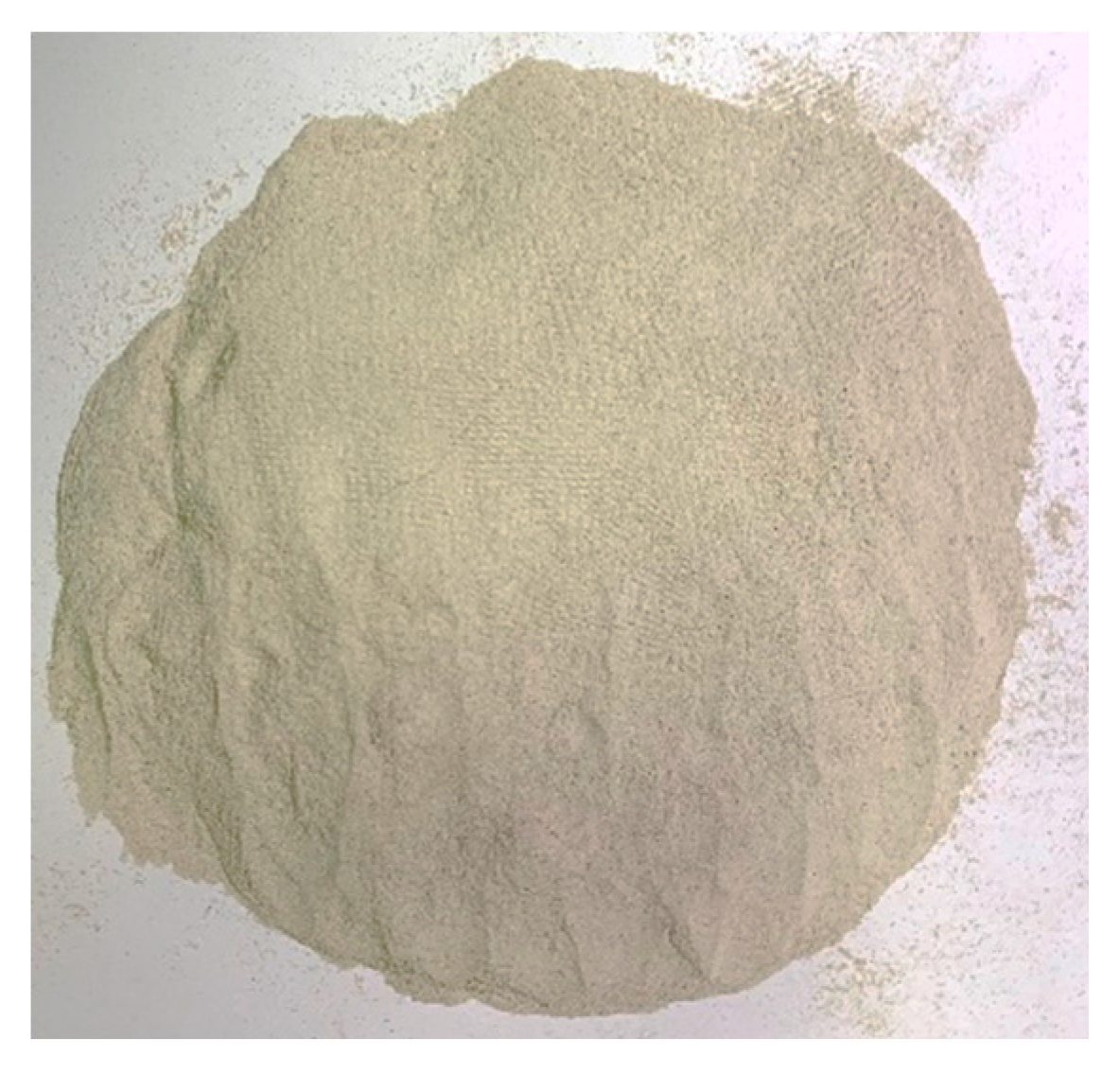

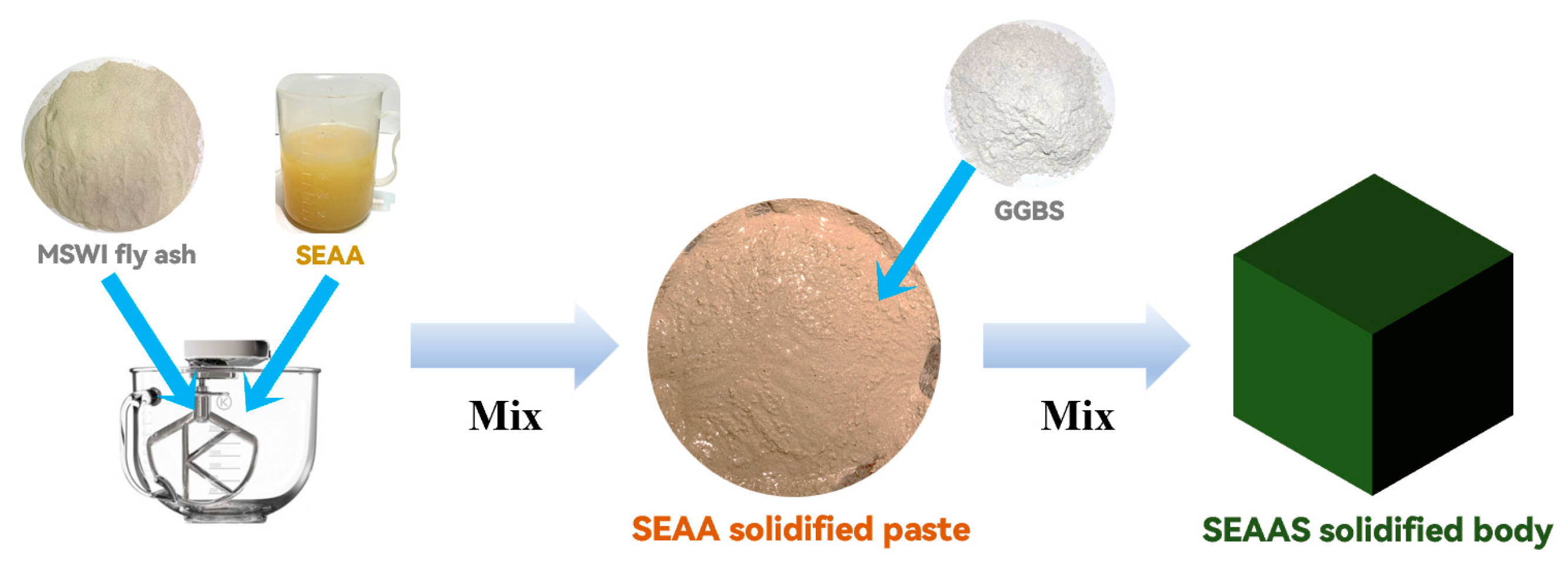
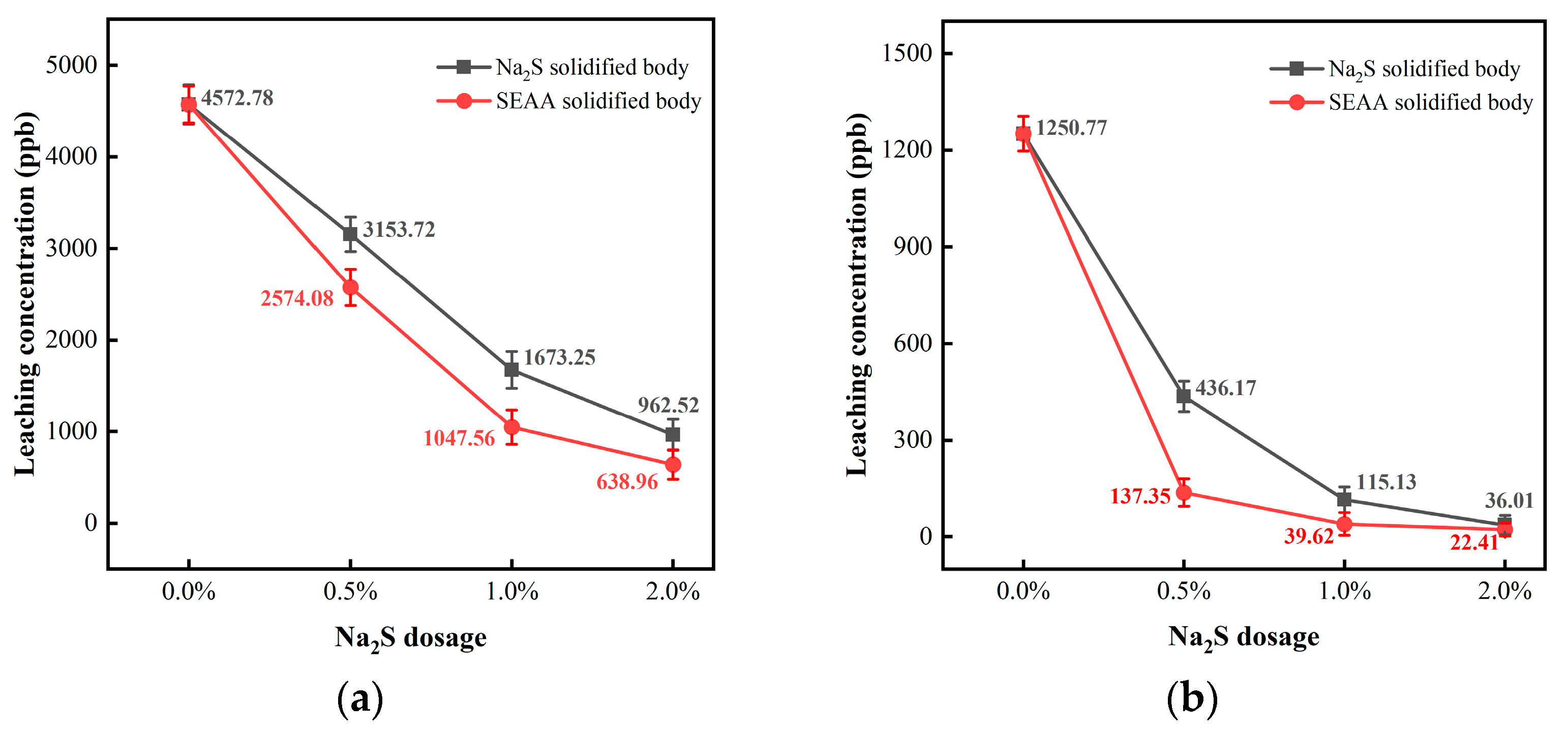
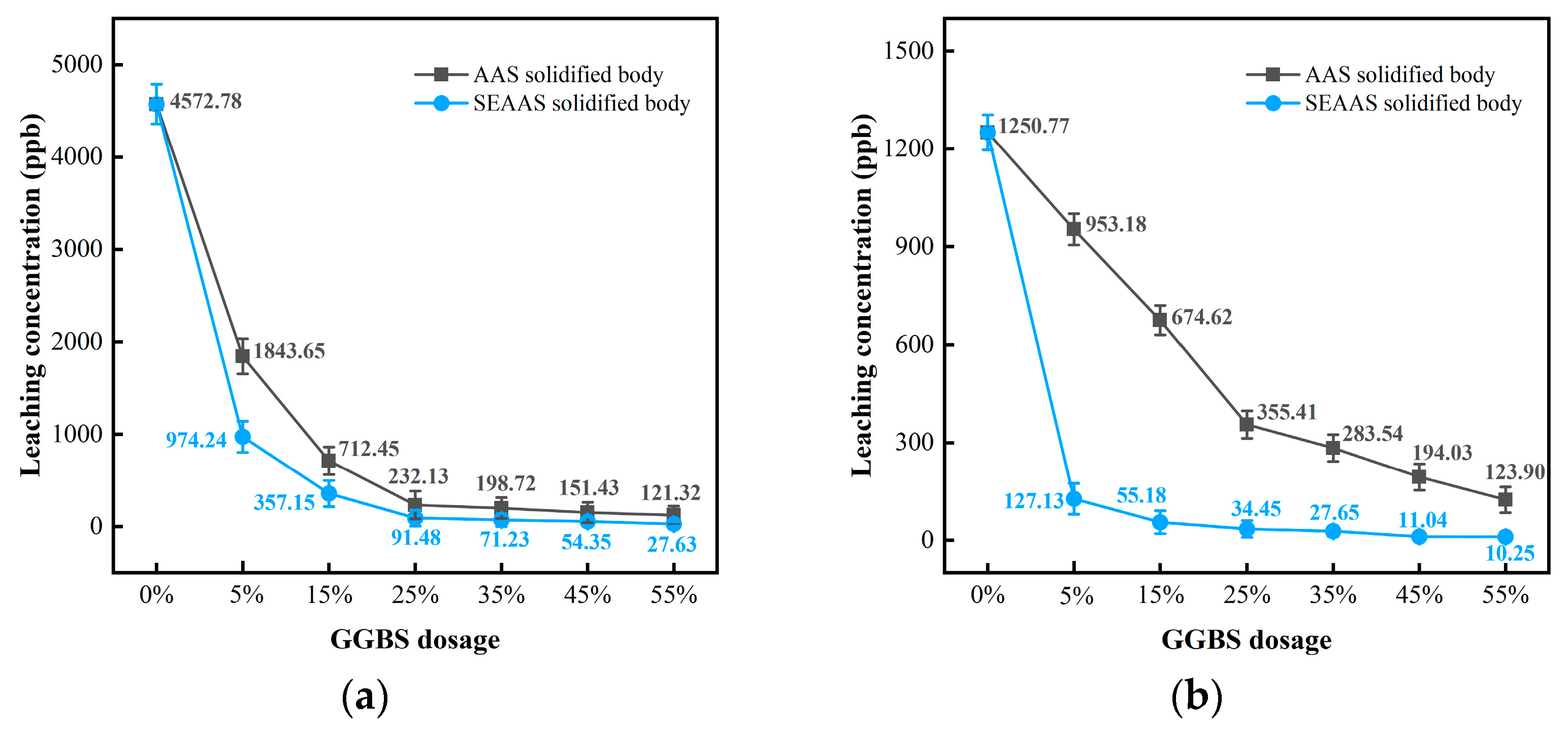
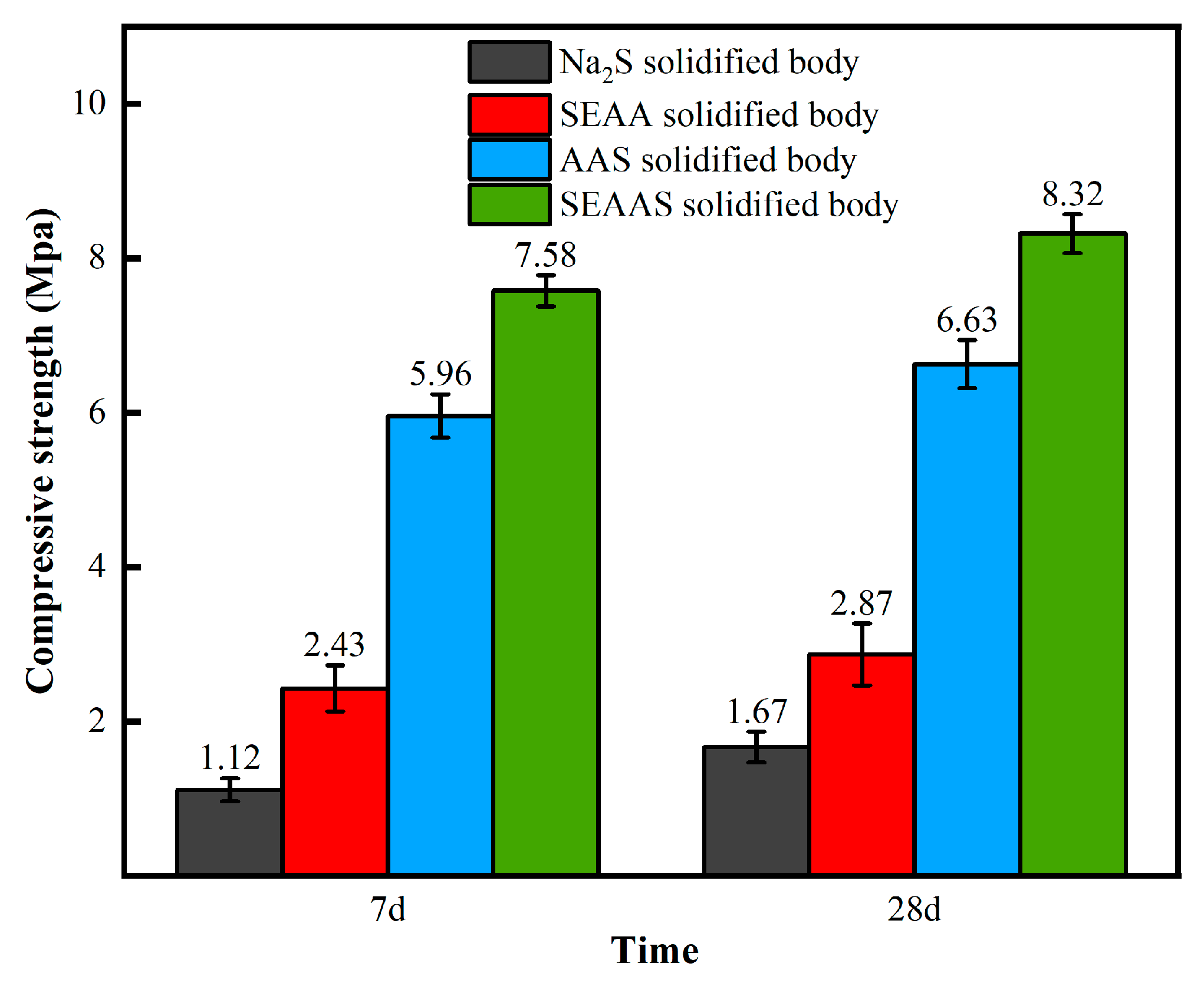
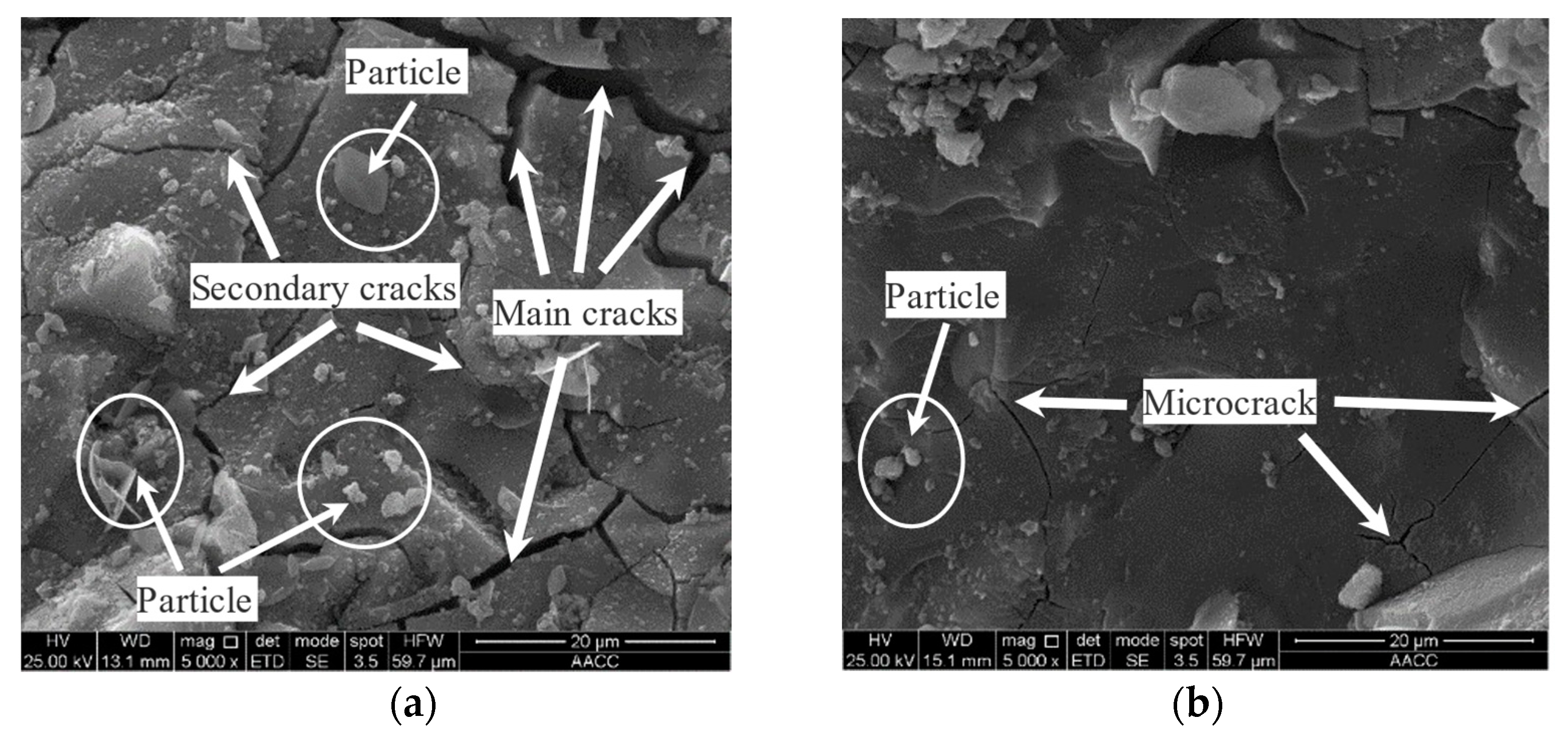
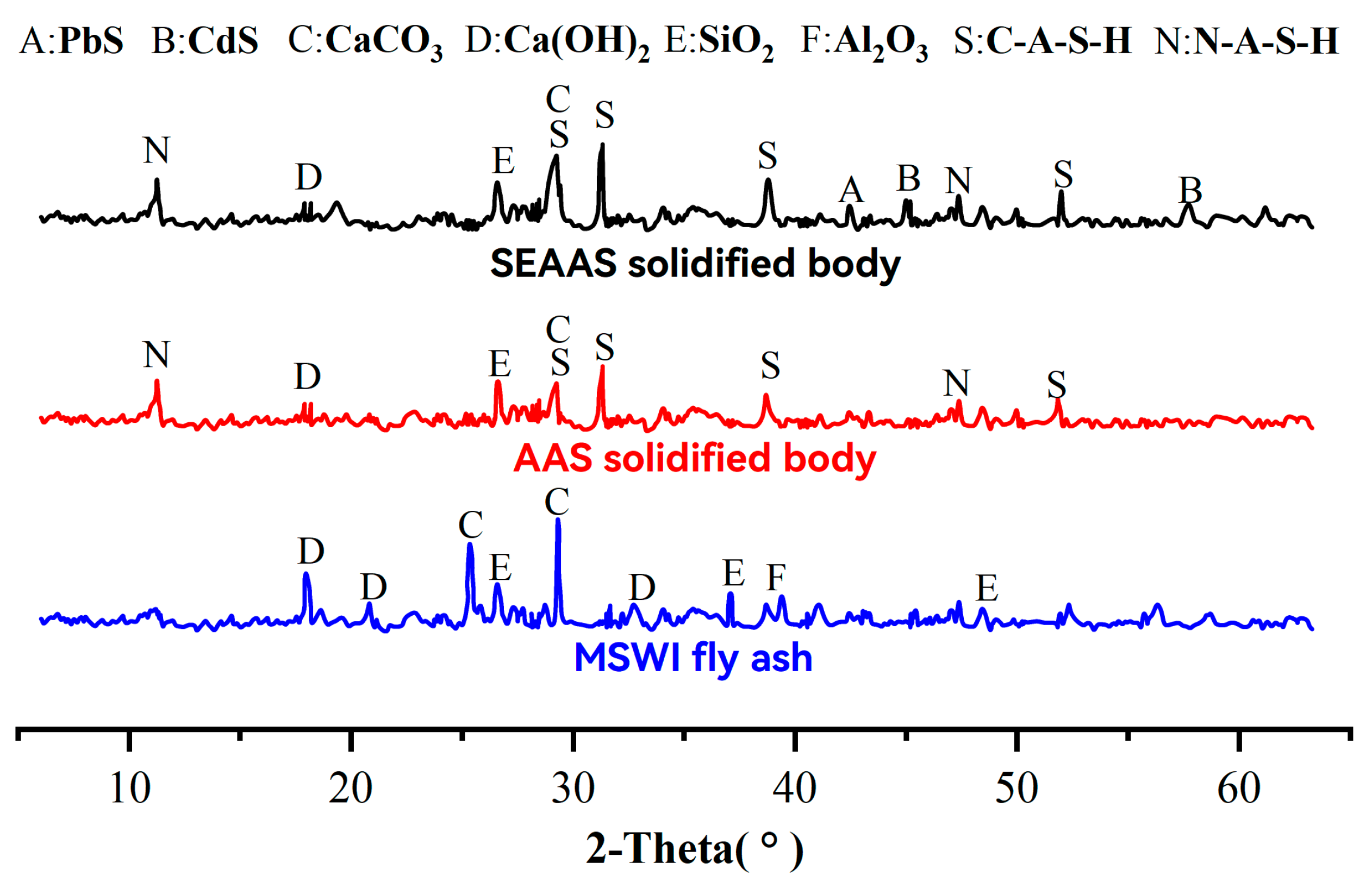

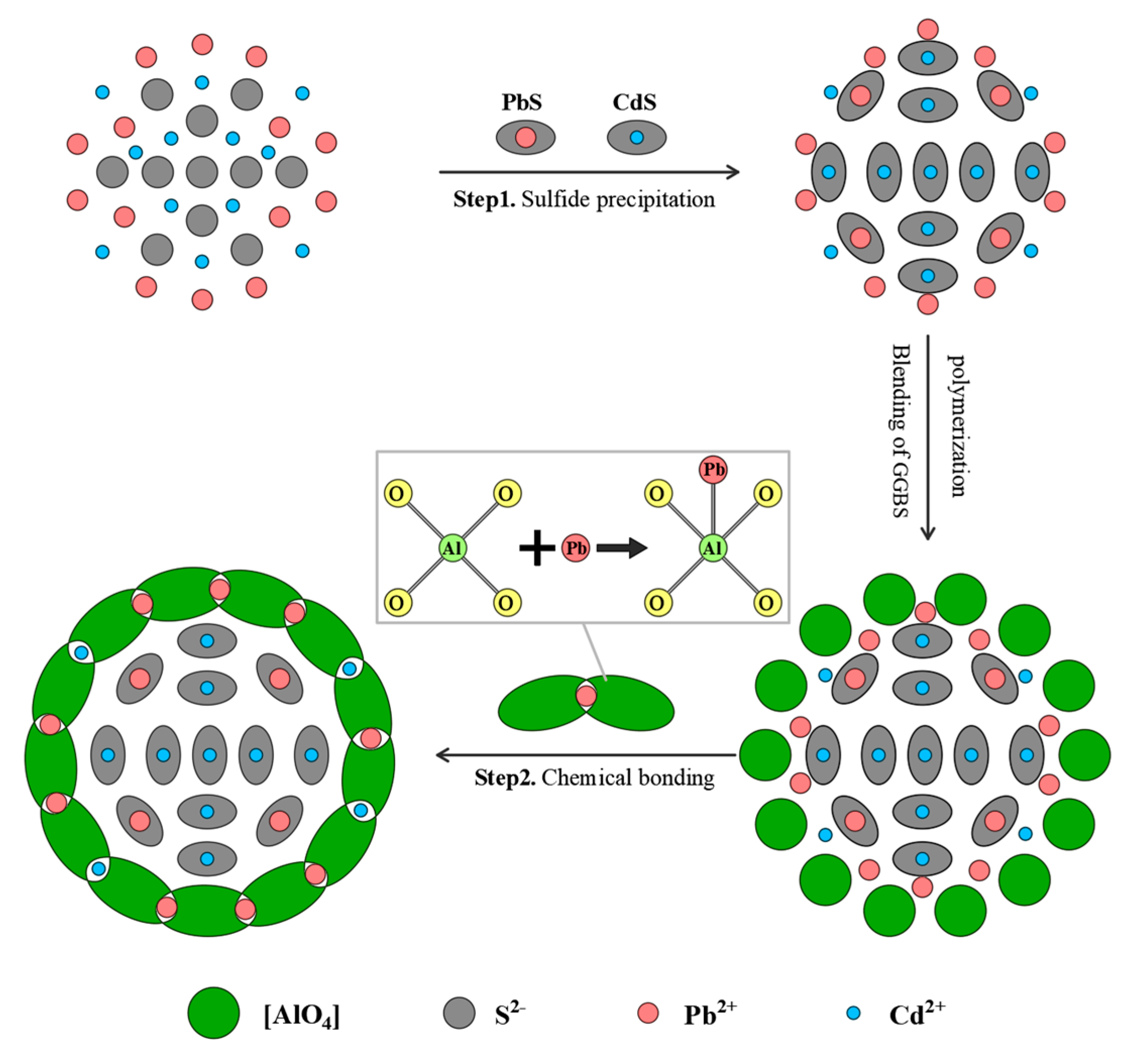
| CaO | SiO2 | A12O3 | Fe2O3 | MgO | Na2O | |
|---|---|---|---|---|---|---|
| MSWI fly ash | 38.62 | 17.21 | 7.02 | 1.79 | 4.01 | 3.11 |
| GGBS | 34.65 | 31.35 | 18.65 | 0.57 | 9.31 | 0.41 |
| Be | Cr | Ni | Cu | Zn | Se | Cd | Ba | Pb | |
|---|---|---|---|---|---|---|---|---|---|
| MSWI fly ash | 0.65 | 241.92 | 26.09 | 3080.07 | 15,652.9 | 14.42 | 1250.77 | 2602.24 | 4572.78 |
| GB 5085.3-2007 | 20 | 4500 | 500 | 40,000 | 100,000 | 100 | 150 | 25,000 | 250 |
| Chemical Reagent | Purity Specification | Manufacturer |
|---|---|---|
| Sodium sulfide | Analytical Reagent | Fu Chen (Tianjin) Chemical Reagent Co., Ltd., Tianjin, China |
| Glacial acetic acid | Analytical Reagent | Fu Chen (Tianjin) Chemical Reagent Co., Ltd., Tianjin, China |
| Sodium hydroxide | Analytical Reagent | Xilong Chemical Co., Ltd., Shantou, China |
| Activator | PH Value |
|---|---|
| Alkali activator | 13.81 |
| SEAA | 13.94 |
| Chemical Composition (wt%) | MSWI Fly Ash | AAS Solidified Body | SEAAS Solidified Body |
|---|---|---|---|
| CaO | 38.62 | 43.23 | 42.69 |
| SiO2 | 17.21 | 23.18 | 23.26 |
| CO3 | 21.9 | 6.12 | 5.88 |
| Al2O3 | 7.02 | 10.56 | 9.83 |
| MgO | 4.01 | 2.12 | 2.06 |
| Na2O | 3.11 | 8.95 | 10.03 |
| Fe2O3 | 1.79 | 1.13 | 1.02 |
| K2O | 1.28 | 0.95 | 0.79 |
| S | 0.56 | 0.73 | 3.24 |
| PbO | 0.0847 | 0.0371 | 0.0306 |
| CdO | 0.0432 | 0.0315 | 0.0237 |
| Pb | 0.0155 | 0.0013 | 0.0097 |
| Cd | 0.0102 | 0.0087 | 0.0205 |
Disclaimer/Publisher’s Note: The statements, opinions and data contained in all publications are solely those of the individual author(s) and contributor(s) and not of MDPI and/or the editor(s). MDPI and/or the editor(s) disclaim responsibility for any injury to people or property resulting from any ideas, methods, instructions or products referred to in the content. |
© 2023 by the authors. Licensee MDPI, Basel, Switzerland. This article is an open access article distributed under the terms and conditions of the Creative Commons Attribution (CC BY) license (https://creativecommons.org/licenses/by/4.0/).
Share and Cite
Xue, Q.; Ji, Y.; Ma, Z.; Zhang, Z.; Xu, Z. Solidification Mechanism of Pb and Cd in S2−-Enriched Alkali-Activated Municipal Solid Waste Incineration Fly Ash. Materials 2023, 16, 3728. https://doi.org/10.3390/ma16103728
Xue Q, Ji Y, Ma Z, Zhang Z, Xu Z. Solidification Mechanism of Pb and Cd in S2−-Enriched Alkali-Activated Municipal Solid Waste Incineration Fly Ash. Materials. 2023; 16(10):3728. https://doi.org/10.3390/ma16103728
Chicago/Turabian StyleXue, Qi, Yongsheng Ji, Zhanguo Ma, Zhongzhe Zhang, and Zhishan Xu. 2023. "Solidification Mechanism of Pb and Cd in S2−-Enriched Alkali-Activated Municipal Solid Waste Incineration Fly Ash" Materials 16, no. 10: 3728. https://doi.org/10.3390/ma16103728





